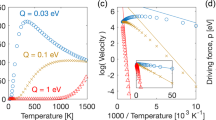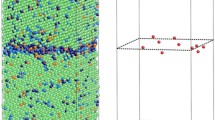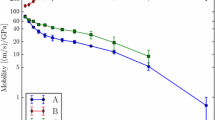Abstract
We used an Ising model to determine whether boundary mobility is an intrinsic material parameter or if it depends on the nature of the driving force for boundary migration. The simulations included both capillarity and external field-driven boundary migration. The external field-driven, flat boundary simulations showed that boundary mobility depends strongly on boundary inclination at low temperature but not at high temperature. On the other hand, the boundary mobility in capillarity-driven migration shows no dependence on boundary inclination and is independent of the boundary migration geometry. An initially circular grain shrinks as a circle and a half-loop boundary retracts with profiles predicted under the assumption that the boundary mobility is isotropic during capillarity-driven migration even when the temperature is very low and the external-field-driven boundary migration is extremely anisotropic. However, when an external field is superimposed on the capillarity driven migration of the circular boundary, the circular grain exhibits well-defined corners consistent with the simulation lattice symmetry. In this case, the boundary mobility is much different than if the external field were omitted. This is a clear demonstration that the boundary mobility can depend on the nature of the driving force for boundary migration.
Similar content being viewed by others
References
M. Winning, G. Gottstein, and L.S. Shvindlerman (unpublished).
D.A. Molodov, G. Gottstein, F. Heringhaus, and L.S. Shvindlerman, Mater. Sci. Forum 294, 127 (1999).
E.M. Fridman, T.W. Kopezkii, and L.S. Shvindlerman, Z. Metallk. 66, 533 (1975).
M. Hillert, Scripta Metall. 17, 237 (1983).
M. Upmanyu, R.W. Smith, and D.J. Srolovitz, Interface Sci. 6, 41 (1998).
M.I. Mendelev and D.J. Srolovitz, Acta Mater. 48, 3711 (2000).
P.A. Rikvold and M. Kolesik, J. Stat. Phys. 100, 377 (2000).
E.M. Fridman, T.W. Kopezkii, L.S. Shvindlerman, and V.J. Aristov, Z. Metallk. 64, 458 (1973).
B.B. Straumal, V.G. Sursayeva, and L.S. Shvindlerman, Fiz. Met. Metalloved. 49, 1020 (1980).
B.B. Rath and H. Hu, Trans. TMS-AIME 236, 1193 (1966).
R.J. Jhan and P.D. Bristowe, in Atomic Scale Calculations of Structure in Materials, edited by M.S. Dan and M.A. Schlüter (Mat. Res. Soc. Symp. Proc. 193, Pittsburgh, PA, 1990), p. 189.
M. Upmanyu, D.J. Srolovitz, J.A. Warren, A. Lobkovsky, and W.C. Carter (unpublished).
S.K. Ma, Statistical Mechanics, (World Scientific, Philadelphia, PA, 1985).
W.K. Burton, N. Cabrera, and F.C. Frank, Philos. Trans. R. Soc. (London) Ser. A 243, 299 (1951).
J.W. Cahn (private communication).
G.R. Van Houten, Ceram. Bull. 38, 301 (1959).
Author information
Authors and Affiliations
Corresponding author
Rights and permissions
About this article
Cite this article
Mendelev, M.I., Srolovitz, D.J., Shvindlerman, L.S. et al. Interface Mobility Under Different Driving Forces. Journal of Materials Research 17, 234–245 (2002). https://doi.org/10.1557/JMR.2002.0033
Received:
Accepted:
Published:
Issue Date:
DOI: https://doi.org/10.1557/JMR.2002.0033




